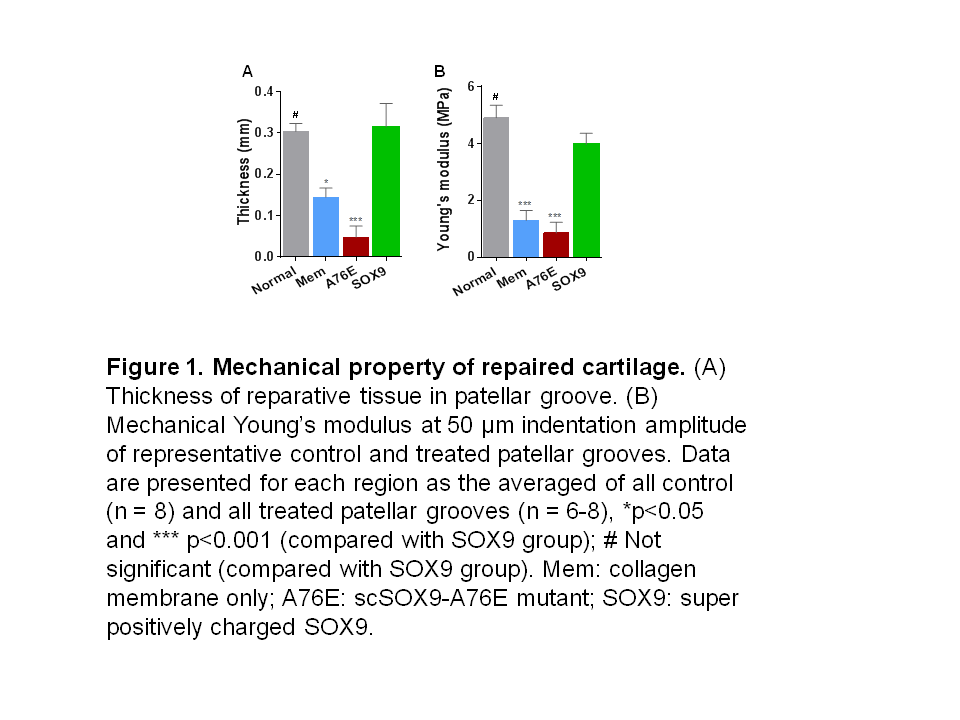Session Information
Date: Sunday, October 21, 2018
Title: 3S085 ACR Abstract: Osteoarthritis & Joint Biology–Basic Science (846–850)
Session Type: ACR Concurrent Abstract Session
Session Time: 2:30PM-4:00PM
 Cartilage defect in rabbits was treated with microfracture with collagen membrane only; with a SOX9 mutant, scSOX9-A76E or with scSOX9 respectively. Rabbits were observed for 12 weeks post-surgery. scSOX9 treated group induced hyaline-like cartilage while collagen-membrane only induced fibrocartilage and mutant scSOX9-A76E poorly induced cartilage repair. The cartilage matrix in scSOX9 treated group showed highly enriched proteoglycan content. The thickness of repaired cartilage induced by scSOx9 was comparable to that of normal cartilage in the same area. Whereas, collagen membrane only induced a thinner layer of cartilage, and scSOX9-A76E treated group showed even worse repaired tissue. In consistent with the histological data and the thickness of the repaired cartilage, the mechanical property of scSOX9 induced cartilage was also similar to that of normal cartilage (Figure 1).
Cartilage defect in rabbits was treated with microfracture with collagen membrane only; with a SOX9 mutant, scSOX9-A76E or with scSOX9 respectively. Rabbits were observed for 12 weeks post-surgery. scSOX9 treated group induced hyaline-like cartilage while collagen-membrane only induced fibrocartilage and mutant scSOX9-A76E poorly induced cartilage repair. The cartilage matrix in scSOX9 treated group showed highly enriched proteoglycan content. The thickness of repaired cartilage induced by scSOx9 was comparable to that of normal cartilage in the same area. Whereas, collagen membrane only induced a thinner layer of cartilage, and scSOX9-A76E treated group showed even worse repaired tissue. In consistent with the histological data and the thickness of the repaired cartilage, the mechanical property of scSOX9 induced cartilage was also similar to that of normal cartilage (Figure 1).
Disclosure: X. Zhang, None; S. Wu, VivoScript, Inc, 3; Y. Zhu, VivoScript, Inc, 3; C. Q. Chu, VivoScript, Inc, 2.
To cite this abstract in AMA style:
Zhang X, Wu S, Zhu Y, Chu CQ. Long Term Efficacy of Cartilage Repair Induced By scSOX9 in Situ with Bone Marrow-Derived Mesenchymal Stem Cells [abstract]. Arthritis Rheumatol. 2018; 70 (suppl 9). https://acrabstracts.org/abstract/long-term-efficacy-of-cartilage-repair-induced-by-scsox9-in-situ-with-bone-marrow-derived-mesenchymal-stem-cells/. Accessed .« Back to 2018 ACR/ARHP Annual Meeting
ACR Meeting Abstracts - https://acrabstracts.org/abstract/long-term-efficacy-of-cartilage-repair-induced-by-scsox9-in-situ-with-bone-marrow-derived-mesenchymal-stem-cells/
